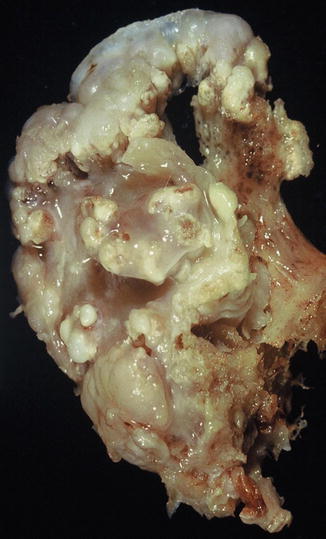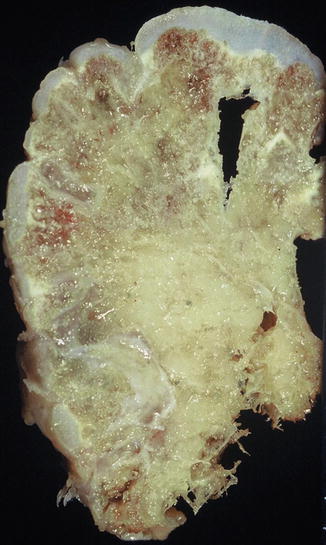Fig. 20.1
X-ray shows multiple osteochondromas arising from the distal meta- and diaphysis of the distal femur, proximal tibia and fibula
The deformities are frequently observed.
Pathology
Gross and Histologic Features
The lesions have the same gross and microscopic appearances as seen in solitary osteochondroma (Figs. 20.2 and 20.3).

Fig. 20.2
Outer surface of one of the multiple osteochondromas shows multi-knobby appearance with gray-white calcified areas

Fig. 20.3
Cut surface shows hyaline cartilage cap with myxoid degeneration
Ancillary Techniques
Genetics
There is evidence that mutations in these two EXT1 and EXT2 genes are responsible for over 70 % of the EXT cases of osteochondromatosis. Among the 49 EXT1 mutations, there are 9 nonsense, 21 frameshift, and 5 splice site mutations; 2 in-frame deletions of 1 and 5 amino acids, respectively; and 12 missense mutations. For EXT2, 8 nonsense, 11 frameshift, 3 splice site, and 3 missense mutations are described. The majority of these mutations are mutations causing loss of function, which is consistent with the presumed tumor suppressor function of the EXT genes.
Mutations in exostosin-1 (EXT1) or exostosin-2 (EXT2), both tumor suppressor genes of the EXT gene family, are associated with multiple osteochondromatosis. All members of this multigene family encode glycosyltransferases involved in the adhesion and/or polymerization of heparin sulfate (HS) chains at HS proteoglycans (HSPGs). HSPGs have been shown to play a role in the diffusion of Ihh, thereby regulating chondrocyte proliferation and differentiation. EXT1 is located at 8q24.11–q24.13 and comprises 11 exons, whereas the 16 exon EXT2 is located at 11p12–p11. To date, an EXT1 or EXT2 mutation is detected in 70–95 % of affected individuals. EXT1 mutations are detected in +/−65 % of cases versus +/−35 % EXT2 mutations in multiple osteochondromatosis patient cohorts.
Stay updated, free articles. Join our Telegram channel

Full access? Get Clinical Tree








